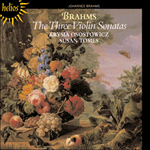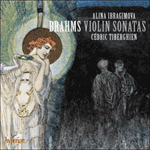
Welcome to Hyperion Records, a British classical label devoted to presenting high-quality recordings of music of all styles and from all periods from the twelfth century to the twenty-first.
Hyperion offers both CDs, and downloads in a number of formats. The site is also available in several languages.
Please use the dropdown buttons to set your preferred options, or use the checkbox to accept the defaults.

| Alina Ibragimova (violin), Cédric Tiberghien (piano)» More |
Much of the tension in the D minor sonata’s opening movement lies beneath the music’s surface: the sotto voce opening bars, with their subdued but agitated accompaniment that has the pianist’s right hand shadowing the left in syncopation; or the central development section, which proceeds almost entirely in pianissimo. The development—traditionally the sonata form’s moment of greatest harmonic instability—is remarkable for its static nature. Having produced an unusually restless exposition, Brahms writes the entire development over an insistently repeated pedal note on the dominant (A) as though in evocation of timpani strokes. The atmosphere of mystery is enhanced through the use of bariolage technique, with the violinist playing the same pitch in rapid alternation between open and stopped strings. The development’s pedal note is counterbalanced in the coda by a similar pedal on the tonic.
The two middle movements are written on a comparatively small scale, allowing Brahms to throw greater weight onto the finale. The adagio has one of those double themes of which Brahms was so fond, in which what at the outset appears to be merely an accompaniment subsequently assumes a thematic life of its own. Here the drooping intervals of the piano part forming a background to the violin’s sonorous opening theme are later transmuted into an expressive melody of melting beauty.
When Brahms sent a manuscript score of the sonata to his close friend Elisabeth von Herzogenberg she was fulsome in her praise, but she nevertheless allowed herself to criticize an episode in the finale whose texture and continual syncopation she found problematic. Brahms made no alteration there, but another suggestion from Herzogenberg seems to have found a response. ‘Write the double-stops at the beginning of the scherzo as pizzi-catos—it sounds twice as good’, she advised. Brahms left the violin part as it was at the opening, but where the same passage returns later in the piece he adopted his friend’s suggestion. The scherzo, which carries the unusual marking of ‘Un poco presto e con sentimento’, inhabits a shadowy world similar to that of the corresponding movement in Brahms’s C minor piano trio, Op 101. The music’s texture is, for the most part, of gossamer lightness and transparency, and at the end the piece disappears in a puff of smoke.
The scherzo’s delicate nature serves to throw into relief the violence of the almost orchestrally conceived finale. The finale’s theme itself is written against the rhythmic background of a tarantella, but there is also a recurring episode in the nature of a chorale, and the tail-end of its melody is later transformed into an abrupt idea more in keeping with the movement’s overall character. The chorale melody itself serves as a distant reminder of the calm second subject in a much earlier D minor work by Brahms: the piano concerto No 1.
from notes by Misha Donat © 2019
Dans le mouvement initial de la sonate en ré mineur, l’essentiel de la tension se trouve en filigrane dans la musique: les premières mesures sotto voce, avec leur accompagnement peu étoffé mais agité avec la main droite du pianiste qui suit la gauche en syncope; ou le développement central, qui se déroule presque entièrement pianissimo. Le développement—traditionnellement le moment de plus grande instabilité harmonique de la forme sonate—est remarquable par sa nature statique. Après une exposition d’une exceptionnelle agitation, Brahms écrit tout le développement sur une pédale répétée avec insistance à la dominante—la—comme s’il voulait évoquer des coups de timbales. L’atmosphère de mystère est accrue par l’utilisation de la technique du bariolage, le violoniste jouant la même note en alternance rapide entre corde à vide et corde touchée sur le manche. La pédale du développement est contrebalancée dans la coda par une pédale analogue à la tonique.
Les deux mouvements centraux sont écrits à une échelle relativement restreinte, ce qui permet à Brahms d’accorder davantage d’importance au finale. Dans l’adagio, on trouve l’un de ces doubles thèmes que Brahms affectionnait, où ce qui, au départ, semble être simplement un accompagnement assume ensuite sa propre vie thématique. Ici, les intervalles descendants de la partie de piano formant un arrière-plan au thème initial sonore du violon sont ensuite transmués en une mélodie expressive d’une beauté attendrissante.
Lorsque Brahms envoya une partition manuscrite de cette sonate à sa chère amie Elisabeth von Herzogenberg, elle ne tarit pas d’éloges mais se permit néanmoins de critiquer un épisode du finale dont elle trouvait problématiques la texture et les syncopes incessantes. Brahms n’apporta aucune modification à cet endroit, mais une autre suggestion de Herzogenberg semble avoir trouvé une réponse. «Écrivez les doubles cordes au début du scherzo comme des pizzicatos—ça sonnera beaucoup mieux», lui conseilla-t-elle. Brahms laissa la partie de violon telle quelle au début, mais là où le même passage revient plus loin, il adopta la suggestion de son amie. Le scherzo, qui porte l’indication inhabituelle «Un poco presto e con sentimento», évolue dans un univers mystérieux analogue à celui du mouvement homologue du trio avec piano, op.101, de Brahms. La texture de la musique est en majeure partie d’une légèreté et d’une transparence arachnéennes et, à la fin, la pièce part en fumée.
La nature délicate du scherzo sert à mettre en évidence la violence du finale presque conçu de manière orchestrale. Le thème du finale lui-même est écrit sur un fond rythmique de tarentelle, mais il y a aussi un épisode récurrent dans le style d’un choral, dont la toute fin de la mélodie est ensuite transformée en une idée brusque qui correspond mieux au caractère général du mouvement. La mélodie de choral elle-même nous rappelle vaguement le calme second sujet d’une œuvre en ré mineur que Brahms avait écrite beaucoup plus tôt: le concerto pour piano n° 1.
extrait des notes rédigées par Misha Donat © 2019
Français: Marie-Stella Pâris
Die Spannung zu Beginn der Sonate d-Moll liegt hauptsächlich unter der Oberfläche der Musik: einmal sind da die sotto-voce-Anfangstakte mit ihrer verhaltenen und doch bewegten Begleitung, wobei die rechte Hand des Pianisten der linken in Synkopen folgt, und dann die zentrale Durchführung, die fast vollständig im Pianissimo erklingt. Diese Durchführung—normalerweise der harmonisch instabilste Abschnitt innerhalb der Sonatenform—ist aufgrund ihres stillstehenden Wesens bemerkenswert. Auf die ungewöhnlich unruhige Exposition lässt Brahms eine Durchführung folgen, die gänzlich über einem hartnäckigen, wiederholten Orgelpunkt auf der Dominante (A), welcher Paukenschläge zu imitieren scheint, erklingt. Die geheimnisvolle Atmosphäre wird durch den Einsatz der Bariolage-Technik verstärkt—dabei erklingt auf der Geige der gleiche Ton auf zwei benachbarten Saiten im schnellen Wechsel, wobei die eine Saite leer gespielt und die andere abgegriffen wird. Der Orgelpunkt der Durchführung wird in der Coda durch einen ähnlichen Orgelpunkt auf der Tonika ausgeglichen.
Die beiden Mittelsätze sind relativ klein angelegt, so dass Brahms dem Finale größeres Gewicht verleihen konnte. Das Adagio hat eines jener Doppelthemen, die Brahms so gern verwendete. Was hier zunächst lediglich Begleitung zu sein scheint, nimmt später eine eigene Thematik an. Die abwärts gerichteten Intervalle des Klavierparts ergeben dabei den Hintergrund zu dem klangvollen Anfangsthema der Violine und verwandeln sich dann in eine expressive Melodie von herzerweichender Schönheit.
Als Brahms eine Manuskript-Partitur der Sonate an seine gute Freundin Elisabeth von Herzogenberg schickte, lobte sie das Werk sehr, erlaubte sich jedoch auch eine Kritik an einer Episode im Finale, deren Struktur und stetige Synkopen sie für problematisch befand. Brahms nahm an dieser Stelle keine Änderungen vor, doch ein weiterer Vorschlag von ihr wurde offensichtlich berücksichtigt: „Schreiben Sie doch die Doppelgriffe im Scherzo anfangs für Pizzicato—es klingt noch einmal so gut.“ Brahms beließ die Violinstimme zu Beginn in der ursprünglichen Form, nahm den Vorschlag jedoch an, wenn dieselbe Passage an späterer Stelle zurückkehrt. Das Scherzo, das mit der ungewöhnlichen Anweisung „Un poco presto e con sentimento“ versehen ist, bewohnt, ähnlich dem entsprechenden Satz in Brahms’ c-Moll-Klaviertrio, op. 101, eine schemenhafte Welt. Die Struktur der Musik ist größtenteils von hauchzarter Leichtigkeit und Transparenz und löst sich am Ende in eine Rauchwolke auf.
Der zarte Charakter des Scherzos hebt die Heftigkeit des fast orchestral angelegten Finales deutlich hervor. Das Finalthema selbst ist gegen den rhythmischen Hintergrund einer Tarantella gesetzt, doch erklingt auch wiederholt eine choralartige Episode, deren melodischer Schlussteil später in ein abruptes Motiv umgewandelt wird, welches dem Gesamtcharakter des Satzes viel mehr entspricht. Die Choralmelodie selbst dient als Erinnerung an das ruhige zweite Thema eines deutlich früheren d-Moll-Werks von Brahms—sein erstes Klavierkonzert.
aus dem Begleittext von Misha Donat © 2019
Deutsch: Viola Scheffel
 Brahms: The Three Violin Sonatas Brahms: The Three Violin Sonatas‘Subtle enough to suggest that for both artists these performances were a revelatory voyage of discovery’ (Gramophone) ‘Krysia Osostowicz and Susan Tomes have a wonderful naturalness about their playing; it is true chamber music’ (The Times)» More |
 Brahms: Violin Sonatas Brahms: Violin SonatasAnother important release from the pre-eminent duo of Alina Ibragimova and Cédric Tiberghien brings matchless accounts of Brahms’s three violin sonatas, with a Clara Schumann encore to conclude.» More |

